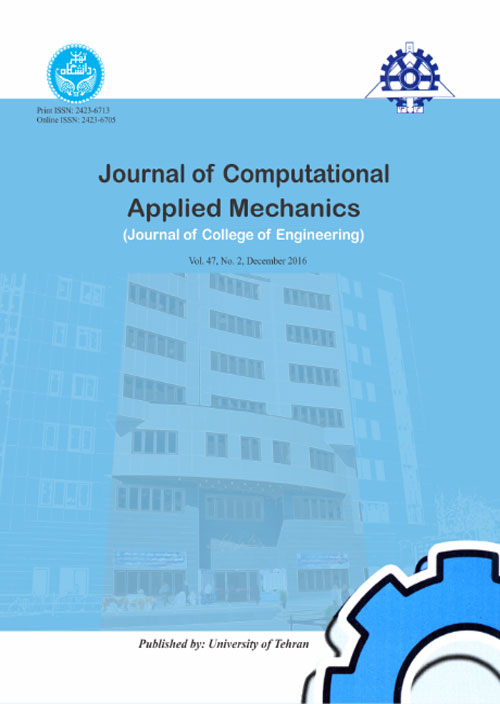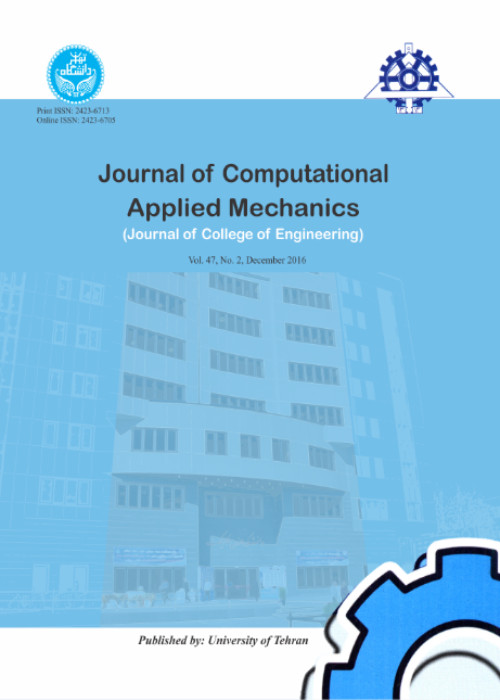فهرست مطالب

Journal of Computational Applied Mechanics
Volume:52 Issue: 3, Sep 2021
- تاریخ انتشار: 1400/07/21
- تعداد عناوین: 10
-
-
Pages 366-393In the present study, time-dependent thermo-elastic creep behavior and life assessment of rotating thick-walled cylindrical shells made of 304L austenitic stainless steel (304L SS) are investigated based on the third-order shear deformation theory (TSDT). Loading is composed of a uniform internal pressure, distributed temperature field, and a centrifugal body force due to rotating speed. Norton’s law is utilized as the material creep constitutive model. Using the minimum total potential energy principle, a system of differential equations in terms of displacement and boundary conditions are derived. Then, the governing equations are solved with an analytical approach, which leads to an accurate solution. Subsequently, an iterative procedure is also proposed to determine the stresses and deformations at different creep times. Larson-Miller Parameter (LMP) and Robinson's linear life fraction damage rule are employed for assessing the creep damages and the remaining life of cylindrical shells. To the best of the researcher’s knowledge, in the previous studies, there is no study carried out into third-order shear deformation theory for thermo-elastic creep analysis of cylinders. To validate the accuracy of the suggested method based on TSDT, a comparison among analytical results and those of the finite element method (FEM) is performed and very good agreement is found. The results indicate that the present analysis is accurate and computationally efficient.Keywords: Creep, Life assessment, Rotating thick cylindrical shell, 304L austenitic stainless steel, Third-order shear deformation theory
-
Pages 394-407In this study, the vibrations of a viscoelastic microplate in incompressible still fluid are investigated. The microplate is supposed simply supported in stationary fluid and made of viscoelastic material that follow the Leaderman viscoelastic model The fluid inertial effects as well as fluid damping on microplate vibration are also studied by applying three dimensional aerodynamic theory. The added mass values are obtained for various aspect ratios of the microplate and compared with available models. The non-classic stress and couple-stress tensors are calculated based on consistent couple stress theory and Leaderman integral. The resultant virtual works inserted in Hamilton’s principle and the governing equations of motion are derived. These coupled equation are simplified by Galerkin method and solved using harmonic balance analytical method. The results show that considering the added mass effects reduces the microsystem nonlinearity.Keywords: microplate, fluid effects, added mass, consistent couple stress, Viscoelastic
-
Pages 408-422The study of material behavior in the presence of defects is one of the studies that can help us recognize and predict material behavior. Studying the behavior of materials in nanoscale illuminates a broad view of the behavior of materials. A variety of studies are available for such a study: numerical, experimental, and quasi-experimental methods. Molecular dynamics is one of the methods that can be used to study the behavior of materials. The vibrational behavior of structures has been the focus of many researchers to analyze and investigate mortar materials' properties. The study of vibrational behavior at the nanoscale can give us a broad view of materials' properties. Therefore, in this study, we study nanowires' vibrational behavior in the presence of edge cracks using molecular dynamics. The influence of crack position and depth on the natural frequencies and shape of iron nanobeam modes with BCC crystal structure have been investigated. Clamped-Clamped boundary conditions with different cracks position and depth have been applied by simulating molecular dynamics. Also, the data obtained from molecular dynamics simulations have been compared with the finite element method and different crack models in one dimensional beams . In order to extract the shape of natural modes and frequencies by molecular dynamics method, FFT applied on the displacement history of nanobeam atoms after excitation of an amplitude in the center of nanobeam in x and y directions have been used. The crack models studied in this study were linear and rotational crack models on beams with Timoshenko theory. Molecular dynamics simulation data compared to other methods have shown a decrease in the value of natural frequencies in the presence of cracks. Also, finite element data and molecular dynamics are well matched. However, the molecular dynamics method has shown a more significant reduction in natural frequency values than finite element methods and various crack models with Timoshenko theory. We have also found that in molecular dynamics bribery, the initial excitation type of nanobeams is very useful in extracting nanobeam modes' shape.Keywords: Cracked nanobeam, Molecular dynamics simulation, Analytical formulation, finite element method, Vibrational analysis
-
Pages 423-432With increasing growth of industrial units in developing countries and pollutants produced by these units, nowadays distribution and dispersion modelling of atmosphere pollutants especially in urban areas is an inevitable importance. Dispersion modelling of atmosphere pollutants is a methodology to estimate focus and concentration values of pollutants related to emission source in different seasons. In current study, using numerical analysis, a thermal diffusion of flare and focus values of industrial pollutants simulation using air zonal methodology has been presented. After studying pollutants emission in open area, validation has been done using laboratory data results and computational fluid dynamics method. The results of this study indicate the ability of presented air zonal methodology to predict thermal diffusion of flare and distribution concentration of pollutant source and information gained from this analysis. Then an exploration of effective parameters in pollution emission such as wind velocity, flare height, and pollution emission rate in downstream has been done. As the results show, when wind velocity rises by 130%, pollution will reach far away from production source and with increase in flare height by 25%, the pollution concentration values on the ground has been reduced by 44%. Also with addition of barrier in pollution dispersion path, pollution level will increase by 60%.Keywords: Flare, Zonal methodology, Pollution diffusion, Special cells
-
Pages 433-450The aim of the present paper is to analytically study the nonlinear forced vibration of a rectangular plate floating on the fluid by Modified Multiple Time Scales method for the first time. It is assumed that the fluid is stationary, incompressible, non-viscous, and non-rotational, and the plate is subjected to transversal excitation. The boundary condition is considered to be simply supported. Using von Karman nonlinear strain displacement relationships, the extended Hamilton principle, and FSTD plate theory, the partial differential equations of motion are derived. The fluid is mathematically modeled by Bernoulli equation and the velocity potential function. Galerkin method is then applied for converting the nonlinear partial differential equations into time-dependent nonlinear ordinary differential equations. The resulted equations are solved analytically by the Modified Multiple Scales Method, thereafter. Despite the large number of derivatives and calculations of the conventional multiple scale method, this approach is very simple and straightforward. The results reveal an excellent agreement with the traditional Multiple Scales method results and existing studies, and are more accurate than other available results. The effect of the presence of fluid near the plate on natural frequency and amplitude of vibration of plate are studied. The effects of some key parameters of the system are also examined.Keywords: Modified Multiple Scales Method, Multiple Scales method, Nonlinear vibration, nonlinear forced vibration of plate floating on the fluid
-
Pages 451-477Following the advances in Computer-Aided Design (CAD) and Additive Manufacturing (AM), with regards to the numerous benefits of the Fused Deposition Modeling (FDM) as a popular AM process, resolving its weaknesses has become increasingly important. A serious problem of the FDM is the dimensional error or size difference between the CAD model and the actual 3D printed part.In this study, the approach is compensating the error regardless of its source. At First, all parameters affecting the dimensional accuracy of FDM are comprehensively identified. Then, multi-input–single-output (MISO) data is prepared by designing experiments using the Taguchi method and obtaining the results from 3D printed samples. Next, a GMDH neural network is applied, which uses a simple nonlinear regression formula in each neuron but can create very complex neuron combinations. So, it is possible to analyze small or even noisy data. Regulatory parameters of the Neural Net have been optimized to increase efficiency. The case study shows a decrease in the RSME for the Nominal CAD Model from 0.377 to 0.033, displaying the compensator's efficiency.Keywords: Additive Manufacturing, Fused Deposition Method, Error Compensation Model, GMDH Neural Network
-
Pages 478-497Vibrational behavior prediction of a laminated composite beam on Winkler-Pasternak’s medium is analyzed in the present article. The proposed beam contains four smart actuating layers of magnetostrictive material to vibration control of the system with a simple constant feedback control gain distribution. The designed structure undergoes an external force in x direction and a magnetic field. A higher-order shear deformation theory with an exponential shape function is used to model the proposed system. Hamilton’s principle and Navier’s approach are used to obtain and solve the dynamic system. The natural frequencies, deflections, and suppression time of the studied system are computed for different thickness ratios, ply orientations, number and location of the magnetostrictive layers, foundation stiffness, velocity feedback gain value, and external force.Keywords: Laminated composite beam, magnetostrictive actuating layers, higher-order shear deformation theory, Winkler-Pasternak’s medium, external force
-
Pages 498-506Indirubin can be applied as an anti-cancer drug for inhibition of brain tumors. However, its performance is reduced due to hydrophobicity. In this study, we synthesized cationic human serum albumin (CHSA) nanoparticle by a new hybrid approach (with chemical and mechanical base) for improvement the surface chemistry of albumin and the amount of indirubin loaded CHSA nanoparticle. In this study, the generated mechanical force from a high-pressure homogenizer (HPH) was used to make nanoparticles with a certain size with narrow polydispersity. The results indicated that the size of indirubin loaded CHSA nanoparticles were 130 nm and their zeta potential were +9. Besides, the encapsulation efficiency and drug loading capacity were found to be 85% and 5.8 %, respectively. To the best to our knowledge, this is the first time that indirubin has been used in albumin nanoparticles. In this study, indirubin loaded CHSA nanoparticles was shown can be a potential candidate for drug delivery in the treatment of glioblastoma. Moreover, the cationized form allows the chemical agent to be transmitted to the brain.Keywords: Brain tumor, Cationated Human Serum Albumin, Indirubin, Glioblastoma, Protein Nanoparticles, sustained release
-
Pages 507-534In this study, the nonlinear free vibration of a nano-disk considering small scale effects has been investigated by using the nonlocal elasticity. To take into account the nonlinear geometric effects, the nonlinear model of von Karman strain has been used while the governing differential equation was extracted according to Hamilton principle. The Galerkin weighted residual method in conjunction with the variational iteration method (VIM) was introduced to solve the governing equations for simply supported and clamped edge boundary conditions. For further comparison, the nonlinear equation was solved using the fourth-order Runge-Kutta method. Very good agreements were observed between the results of both methods, while the former method made the solution much easier. Additionally, it was observed that the ratio of thickness to radius, h/R, plays an important role on the nonlinear frequencies. This effect appears to be minute if the local elasticity theory is adopted. However, results indicated that the nonlocal effect may be ignored provided h/R ratio is very small.Keywords: Nonlinear free vibration, nano-disks, Nonlocal Elasticity Theory, Von Karman strain
-
Pages 535-552
Classical theories do not have the ability to study the behavior of materials at the nanoscale. Accordingly, new theories have been developed to predict the behavior of materials at the nanoscale. Some of these theories are nonlocal elasticity, strain gradient theory, couple stress theory and surface effect theory. In most articles, the authors use differential form of nonlocal elasticity theory. Recently, a number of authors have used the integral form of this theory and obtained interesting results. Therefore, in this research, articles related to the integral form of non-local theory have been examined for small-scale tubes, beams, shells, and plates.
Keywords: Nonlocal Elasticity Theory, stress-driven method, strain-driven method, strain gradient model, Functionally Graded Material, Scale parameter


